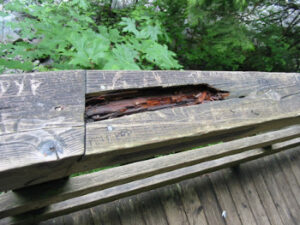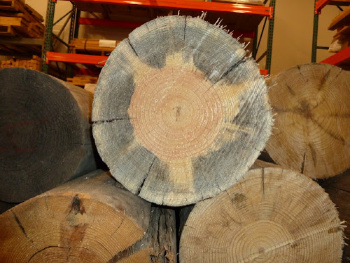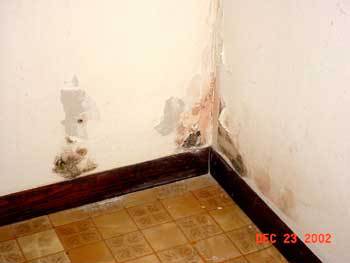Problems with Green Lumber – Part 1: Fungi

Green Lumber
Green lumber refers to lumber that is freshly sawn. This is not what you will find at a local hardware store or big box store. However, green lumber is still common in rural areas and for wood working hobbyists. Trees often have a sentimental value to them. So, when a large tree falls or dies it is a good idea to try to salvage it by converting it into a bird house, table, etc. You can do this yourself if you have the equipment or work with a local portable sawmill company. In any event, you will be dealing with green lumber which should be dried prior to use. If you are air drying the wood, it will be at risk of biological attack from insects and fungi while the moisture content is elevated.
Fungi Basics
For a fungus to be active in wood, there are four essential elements – air, temperature, moisture, and food. If you remove one of the four elements, you can eliminate the risk of fungal damage. Air is the hardest to control. The key here is to create an anerobic environment which can be done by saturating the wood with water. Some small operators will store logs in a pond and larger operators use a sprinkler system to achieve an anerobic environment. Fungi need temperatures of 50 – 110 F for active growth. If the temperature is outside of this range, it is dormant; temperature over 130 F is toxic to most fungi. Fungi typically need at least 25 percent moisture content to be active. Rapid drying will reduce the risk of fungi attack, especially blue stain fungi, due to moisture content.
The food (wood) can be poisoned with a wood preservative. Since air drying is not a good option during warm, humid summer months. Dipping or spraying the lumber with a fungicide can be used. This protects the outer 1/100 of an inch and creates an envelope of protection. Fungicides must be applied immediately after sawing. If the application is delayed, then the fungi can penetrate to the center of the board when the fungicide is applied. Always follow all label instructions when using a biocide. The label is the law.
The most immediate threat to green lumber is fungi. These are simple plants that do not contain chlorophyll. They cannot produce their own food, so fungi get their energy from other organic materials (e.g., wood). The cellulose and lignin in wood provide food for a wide range of fungi. The hyphae (mycelium) of the fungi secrete enzymes that break down the carbohydrate materials, and sometimes lignin, into simple sugar-like compounds that are used for energy (metabolized). Most fungi can only attack wood in wood moisture is already present. However, there are some water conducting species of fungi that have the ability to transport water to the wood material affected.
Blue Stain

(Photo Courtesy of Dr Stan Lebow, US Forest Products Lab)
This fungus is dark blue in color and is obvious if present in light colored wood species such as maple, hackberry, poplar, hemlock, spruce. Blue stain fungi utilize the sap in the wood for its food supply. This fungus is only on the surface of the wood and does not reduce the strength. Blue stain, also called sapstain, is the most economically important stain. It
It occurs in the sapwood of both hardwoods and softwoods. Heartwood is essentially immune to the fungus that causes blue stain, but the salability and price of blue-stained lumber are greatly reduced because of its appearance.
Molds and Mildew

(Photo courtesey of USDA Forest Service).
Molds and mildew are another group of fungi that infest wood. Although mold can appear in various colors, it is primarily white and powdery or appears like cotton. Mildews are typically dark and spotted on a wood surface. These fungi, like blue stain fungi, live on the surface of the wood and do not affect strength.
Mold and mildew spores are naturally occurring in the air and can rapidly grow on green lumber. They thrive in damp and dark places. The worst thing you can do with green lumber is to dead stack it and put it in a shed with no HVAC.
Decay Fungi

(Photo Courtesy of Dr Stan Lebow, US Forest Products Lab)
Wood-decay fungi can be classified according to the type of decay that they cause. The best-known types are brown rot, soft rot, and white rot.
Fungi that break down the chemical components of wood are known as decay fungi and are known as either brown rot fungi or white rot fungi. White rot fungi can degrade both lignin and cellulose and are
very common in green lumber and logs. Wood that is infested with white rot fungi tends to retain its shape but will become spongy.
Brown rot fungi also occurs in green lumber but grows much slower and will result in a cubical-style breakdown and consumption of up to two-thirds of the total wood substance. Brown rot fungi will often cause the wood to shrink, check or collapse. These fungi will preferentially attack softwoods but will also attack hardwood lumber and logs
Soft rot fungi typically attack wood that is very wet and usually slowly penetrates the wood. They gradually degrade wood from the surface inward. Soft-rot fungi affect wood exposed to long-term moist conditions. The wood is darkened and appears dull brown or blue-gray, and the surface can easily be scraped off with a probe. Soft-rot fungi display considerable variation in their effects on cell wall chemical constituents during decay development. Soft rot is often confused with white rot because of their similar appearance.
For more information, please read Causes and Control of Wood Decay, Degradation, and Stain.
Meet the Author
Dr. Todd Shupe is the President of Wood Science Consulting, LLC. He is a well-recognized expert on wood forensics, wood preservation, wood decay and degradation, and wood species identification. He has a broad background in new product development, quality management, and marketing and sales in both the public and private sectors. For more information please visit DrToddShupe.com.
We welcome your comments below.
Thank you for visiting. We trust that you have enjoyed reading our articles.
Liked this post? Read more below or search for more topics . . .

